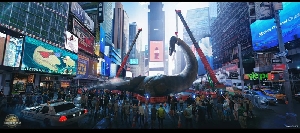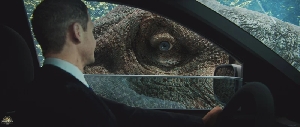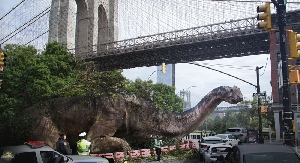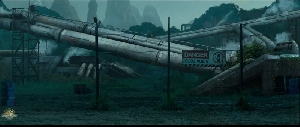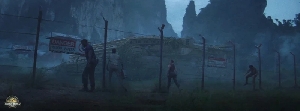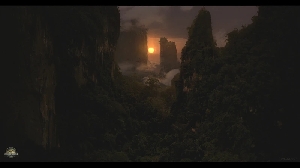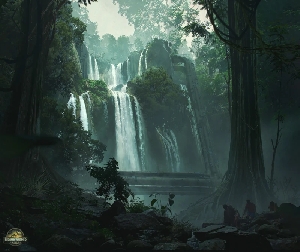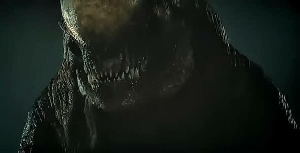Broome titsnosaur
Dinosaurs Forum Topic

Tyrant king
MemberCompsognathusAug 12, 20141311 Views8 Replies230 feet long 126 feet tall and 250 tons
awesomly huge animal
Replies to Broome titsnosaur
Hey Guest, want to add your say?

Interesting. Do you have a link to the article?
Jack of all trades. Master of none

Ok. I have no idea how to do any thing EXEPT write words on this forum
and I'm on my phone

Cool! Well, it's been a while since I posted links, so I forgot how to do it.
“Banana oil.”- George Takei, Gigantis: The Fire Monster


What kind of phone? If it has a touch screen, just hold your finger over the link, and there should be a bar that says something like "Select, Select All, Paste." Hit select all, and there should be a bar that says "Cut, Copy, Paste." Hit copy, then, in the box where you type a response to a topic, hold your finger on the screen. There should be a bar that says "Select, Select All, Paste." Hit paste and that's good enough.
Jack of all trades. Master of none

Found something on it, WARNING, MASSIVE TEXT WALL AHEAD:
Wedel misrepresents the published work of others, including me, and then adds insult to injury by questioning the competence of those he has misrepresented.
He seems unsatisfied, perhaps even irritated, by a preliminary report on Broome (Western Australia) sauropod tracks published in 1994 – which, incidentally, was the joint work of three authors, not just me. As both my co-authors (Tim Hamley and Paul Foulkes) are now dead and unable to defend themselves, I’ll have to respond for all three of us. Let me deal with Wedel’s remarks one by one, though not necessarily in the order in which he presents them.
1) “Thulborn only said that the biggest tracks were up to 150 cm in diameter.”
Nowhere does that 1994 paper state that the biggest tracks “were up to 150 cm in diameter”. I just checked it again (Gaia, vol. 10: 85-94), several times, and there is no such statement or anything resembling it. The word “diameter” appears only once, referring to a camera lens-cap (diameter 5.5 cm) used as an improvised indication of scale in one photograph (caption to Fig. 4D).
Does that 1994 paper mention “only” that single dimension of 150 cm? Page 89 describes sauropod tracks in lagoonal settings: “The pes prints are usually subcircular, elliptical or oval in outline, with a length between 45 cm and 120 cm.” That’s length, not diameter.
Page 92 deals with sauropod tracks in swamp/forest settings: “Most [have]… pes length between 45 cm and 90 cm, though there are a few larger tracks, with pes length greater than 1 m (e.g. Fig. 3D).” Again, that’s length, not diameter.
And (also p. 92) “In addition … [there are] some seemingly novel types… For example, one very large form of pes print, with bean-shaped outline and clearly-defined notches representing the digits, attains a maximum length greater than 150 cm (Fig. 3D).” Once again that’s length, not diameter. And it’s the only point at which a figure of 150 cm is mentioned.2) “… up to 150 cm in diameter. What does that mean–length? Width? Are the tracks perfect circles?”
No. It means that Wedel is inventing imaginary flaws in a paper that he doesn’t seem to have read.3) “Does no one who works on giant sauropod tracks know how to report measurements?”
That statement reveals an undercurrent of baseless innuendo, usually in the form of rhetorical questions.
As it happens, I do know how to report measurements of fossil footprints. So, too, did my co-authors Paul Foulkes and Tim Hamley. Giuseppe Leonardi, author of a standard work on the subject (Glossary and Manual of Tetrapod Palaeoichnology), joined us for one field-season at Broome (1997). He also examined and verified the unusually large footprint (length >150 cm; 1994, Fig. 3D) that Wedel finds so disturbing.4) “… the meta-point, what if the Broome … tracks are underprints?”
In 1994 it was stated (p. 89) that “… we suspect that many of the tracks exposed on bedding planes [in lagoonal settings] are transmitted prints…”.
While it’s not recommended practice, I will respond to Wedel’s rhetorical question by posing another rhetorical question. Is it really necessary to state the obvious?
The footprint measurements we cited are measurements of footprints. They are not measurements of sedimentary structures formed sub-surface. That is, those measurements are from primary moulds (concave epireliefs), impressed directly by the underside of dinosaurian feet, and not from transmitted prints or ‘ghost prints’ (Wedel’s “underprints”).5) “The Broom [sic] tracks have gotten one brief note…”
The “brief note” is 10 pages long (A4, in fairly dense type), with 2 maps, 8 photos and a few dozen references. Wedel cites the pagination as 85-96 whereas it’s actually 85-94 – a trivial point, to be sure, but one which strengthens my growing suspicion that he hasn’t actually looked at the work he disparages.6) “… despite the passing of a decade and a half, the world’s (possibly second-) biggest footprints–from anything! ever!–have not yet merited a follow-up paper.”
And…
“It’s also weird that some of the biggest contenders … have been so little published.”
I don’t want to waste even more time re-stating the obvious and repeating information that’s already been published. That 1994 paper explains why research on the Broome track-sites proves “a challenging and time-consuming task” (p. 87). I’ll save time by adding only a few supplementary remarks.
The 1994 preliminary report is just that – preliminary. It’s a rapid survey of sauropod tracks on rocky shore-platforms at discontinuous coastal exposures of Broome Sandstone scattered over a distance of more than 80 km. The geographic range has now been extended to about 200 km. (And, no, there aren’t any track-sites in the interior of the Dampier Peninsula.)
To paraphrase Wedel: does no one have any conception of the practical challenges and risks attending fieldwork in remote and dangerous areas? It’s not quite as easy as lifting a few specimens off a museum shelf or taking a leisurely stroll over a track-site on dry land. One of the most frustrating problems, acknowledged by every previous investigator, is the difficult and hazardous access. All the coastal exposures (save one) are less than 13 metres thick, and the tidal range is more than 10 metres. Simple calculation (13 minus 10) will tell you that most of the tracks are under water for most of the time.
Ned Colbert’s memoirs relate his own experiences while investigating theropod tracks (Megalosauropus broomensis) at Gantheaume Point, the type section. (And these, by the way, are comparatively well-known and easily accessible footprints, only a short distance from the town of Broome.) Colbert describes how he and his team had to rehearse in the car-park of the Continental Hotel before they even attempted to secure casts of the theropod tracks. They needed to develop a fast and efficient commando-style operation, just to reach the site, snatch some casts and photos (whatever their quality) and then get out before they were inundated by the rising tide.
The Broome dinosaur tracks “can only be viewed [or studied] at very low tides, and unless you know the exact time of month when the tide is out far enough, you may miss the opportunity… In fact, without a proper guide you may not be able to find these footprints…” (from a web-site for tourists, 1998).
There are only brief and infrequent windows of opportunity in which to search out and explore these track-sites, often 30 minutes or less, sometimes as little as 10-15 minutes. And that is only the first and most frequently-mentioned of several major constraints. It takes a long time to assemble a body of data that’s worth publishing, and there’s nothing “weird” about it.7) “… if I had access to … a track 1.5 m wide, you can bet that I’d be dropping everything else like a bad habit until I had the gigapod evidence properly written up.”
No doubt. But I don’t like the thinly-veiled insinuation that tracks have not been “properly written up” in the past, especially when some of my colleagues have risked life and limb to obtain the information that Wedel dismisses as unsatisfactory.
However, the key word is “properly”. I will release my work on the Broome dinosaur tracks when I’m satisfied that I’ve done the job “properly” – however long that might take and however much my conception of work done “properly” might differ from Matt Wedel’s.
Also on the subject: http://paleoking.blogspot.com/2011/11/15-biggest-dinosaurs-youve-never-heard.html
Here, have a waffle (-'.')-#


I did. It might have been absorbed by said text-wall though. They have a habit of doing that.
Here, have a waffle (-'.')-#
Are you an avid Jurassic World fan looking for a dedicated online community of likeminded fans? Look no further! Create your own profile today and take part in our forums and gain XP points for all the content you post!

